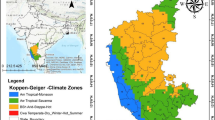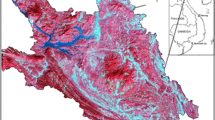Abstract
The Landsat program, which started in 1972 with Landsat-1, continues today with its newest satellite, Landsat-9, launched on 27 October 2021. The Landsat-9 data have been freely distributed since 10 February 2022 on the Earth Explorer platform. However, no scientific study on Landsat-9 for land use/land cover (LULC) mapping has yet been published, focusing on specific eco-systems. Therefore, the present study investigates the potential of Landsat-9 images for LULC classification in forest and agricultural systems. To achieve this, we selected two study areas, i.e. Kaynarca (forest-dominated) and Hocalar (agriculture-dominated), from different ecoregions of Turkey. Then, we mapped their LULCs using Landsat-8 and Landsat-9 data with the Support Vector Machine, K-Nearest Neighbors (K-NN), Light Gradient Boosting Machine (LightGBM), and 3D Convolutional Neural Network (3D-CNN) methods. The classification accuracies were assessed with the F1-score, taking the stand-types maps of the case areas as reference. It was seen that the best maps were generated by the 3D-CNN method with accuracy rates of 88.0% for Kaynarca (Landsat-8) and 87.4% for Hocalar (Landsat-9) at the landscape level. Unlike other methods, 3D-CNN removed the “salt-and-pepper effect” on the maps providing better spatial structure for further analyses. Regardless of the satellite missions, the mapping accuracies for the “productive forest” and “agriculture” classes were > 90% for Kaynarca and Hocalar, respectively. The comparative results suggest that Landsat-9 offers satisfactory LULC maps with similar classification accuracies as Landsat-8 and can be effectively used as a freely available remote sensing resource in monitoring and mapping forest- and agriculture-dominated landscapes.









Similar content being viewed by others
Data availability
Publicly available Landsat-9 and Landsat-8 satellite images that can be downloaded from the USGS website (https://earthexplorer.usgs.gov/) were used in this study.
References
Akar Ö, Güngör O (2015) Integrating multiple texture methods and NDVI to the Random Forest classification algorithm to detect tea and hazelnut plantation areas in northeast Turkey. Int J Remote Sens 36(2):442–464
Bastin J-F, Berrahmouni N, Grainger A et al (2017) The extent of forest in dryland biomes. Science 356:635–638. https://doi.org/10.1126/science.aam6527
Carranza-García M, García-Gutiérrez J, Riquelme JC (2019) A framework for evaluating land use and land cover classification using convolutional neural networks. Remote Sens 11(3):274
Chrysafis I, Mallinis G, Gitas I, Tsakiri-Strati M (2017) Estimating Mediterranean Forest parameters using multi seasonal Landsat 8 OLI imagery and an ensemble learning method. Remote Sens Environ 199:154–166. https://doi.org/10.1016/j.rse.2017.07.018
Congalton RG, Green K (2009) Assessing the accuracy of remotely sensed data: principles and practices. CRC Press, Boca Raton
Dahigamuwa T, Yu Q, Gunaratne M (2016) Feasibility study of land cover classification based on normalized difference vegetation index for landslide risk assessment. Geosciences 6(4):45
Dingle Robertson L, King DJ (2011) Comparison of pixel- and object-based classification in land cover change mapping. Int J Remote Sens 32(6):1505–1529. https://doi.org/10.1080/01431160903571791
GDF (2015) Ecosystem-based functional forest management plan of the Hocalar Forest Planning Unit (2015–2034). The Turkish General Directorate of Forest, Ankara.
GDF (2017) Ecosystem-based multifunctional forest planning guideline (Code: 299). The Turkish General Directorate of Forest, Ankara.
GDF (2022) Ecosystem-based functional forest management plan of the Kaynarca Forest Planning Unit (2022–2041). The Turkish General Directorate of Forest, Ankara.
Güler M, Yomralıoğlu T, Reis S (2007) Using landsat data to determine land use/land cover changes in Samsun, Turkey. Enrion Monit Assess 127:155–167
Grebner DL, Bettinger P, Siry JP (2013) Introduction to forestry and natural resources. Academic Press, Amsterdam
Hall RJ, Skakun RS, Arsenault EJ, Case BS (2006) Modeling forest stand structure attributes using Landsat ETMþ data: application to mapping of aboveground biomass and stand volume. For Ecol Manag 225:378–390. https://doi.org/10.1016/j.foreco.2006.01.014
Hemati MA, Hasanlou M, Mahdianpari M, Mohammadimanesh F (2021) A Systematic review of landsat data for change detection applications: 50 years of monitoring the earth. Remote Sens 13(15):2869. https://doi.org/10.3390/rs13152869
Huang C, Kim S, Song K, Townshend JRG, Davis P, Altstatt A, Rodas O, Yanosky A, Clay R, Tucker CJ, Musinsky J (2009) Assessment of Paraguay’s forest cover change using Landsat observations. Global Planet Change 67:1–12. https://doi.org/10.1016/j.gloplacha.2008.12.009
Ji S, Zhang C, Xu A, Shi Y, Duan Y (2018) 3D convolutional neural networks for crop classification with multi-temporal remote sensing images. Remote Sens 10(1):75
Kahriman A, Günlü A, Karahalil U (2014) Estimation of crown closure and tree density using Landsat TM satellite images in mixed forest stands. J Indian Soc Remote Sens 42:559–567
Ke G, Meng Q, Finley T, Wang T, Chen W, Ma W et al (2017) Lightgbm: a highly efficient gradient boosting decision tree. In: Proceedings of the Advances in Neural Information Processing Systems, 4–9 December, Long Beach, CA, USA, pp 3147–3155
Khatami R, Mountrakis G, Stehman SV (2016) A meta-analysis of remote sensing research on supervised pixel-based land-cover image classification processes: general guidelines for practitioners and future research. Remote Sens Environ 177:89–100
Kim M, Lee J, Han D, Shin M, Im J, Lee J, Quackenbush LJ, Gu Z (2018) Convolutional neural network-based land cover classification using 2-D spectral reflectance curve graphs with multitemporal satellite imagery. IEEE J Sel Top Appl Earth Obs Remote Sens 11(12):4604–4617
Kuruca M, Küçük MD, Avdan U (2021) The potential of Göktürk 2 satellite images for mapping burnt forest areas. Turk J Agric for 45:91–101. https://doi.org/10.3906/tar-2001-79
Masek JG, Huang C, Wolfe R, Cohen W, Hall F, Kutler J, Nelson P (2008) North American forest disturbance mapped from a decadal Landsat record. Remote Sens Environ 112:2914–2926. https://doi.org/10.1016/j.rse.2008.02.010
Masek JG, Wulder MA, Markham B, McCorkel J, Crawford CJ, Storey J, Jenstrom DT (2020) Landsat 9: Empowering open science and applications through continuity. Remote Sens Environ 248:111968. https://doi.org/10.1016/j.rse.2020.111968
Maxwell AE, Warner TA, Fang F (2018) Implementation of machine-learning classification in remote sensing: an applied review. Int J Remote Sens 39:2784–2817. https://doi.org/10.1080/01431161.2018.1433343
Maulik U, Chakraborty D (2017) Remote Sensing Image Classification: a survey of support-vector-machine-based advanced techniques. IEEE Geosci Remote Sens Mag 5(1):33–52. https://doi.org/10.1109/MGRS.2016.2641240
McCarty DA, Kim HW, Lee HK (2020) Evaluation of light gradient boosted machine learning technique in large scale land use and land cover classification. Environments 7(10):84
McDermid GJ, Hall RJ, Sanchez-Azofeifa GA, Franklin SE, Stenhouse GB, Kobliuk T, LeDrew EF (2009) Remote sensing and forest inventory for wildlife habitat assessment. For Ecol Manag 257:2262–2269. https://doi.org/10.1016/j.foreco.2009.03.005
Mei S, Yuan X, Ji J, Zhang Y, Wan S, Du Q (2017) Hyperspectral image spatial super-resolution via 3D full convolutional neural network. Remote Sens 9(11):1139
Mert A, Aksan Ş, Özkan UY, Özdemir İ (2016) Relationships between the richness of bird species and structural diversity from satellite images of Landsat-8 OLI. Turkish J for 17(1):68–72
Ozdemir İ, Ozkan K, Mert A, Gülsoy S (2010) Monitoring of wetlands by using multitemporal landsat data; a case study from Fethiye—Turkey. In: Gökçekus H, Türker U, LaMoreaux J (eds) Survival and sustainability. Environmental earth sciences book series. Springer, Berlin, Heidelberg
Rahman A, Abdullah HM, Tanzir MT, Hossain MJ, Khan BM, Miah MG, Islam I (2020) Performance of different machine learning algorithms on satellite image classification in rural and urban setup. Remote Sens Appl Soc Environ 20:100410. https://doi.org/10.1016/j.rsase.2020.100410
Sağlam B, Bilgili E, Durmaz BD, Kadıoğulları Aİ, Küçük Ö (2008) Spatio-temporal analysis of forest fire risk and danger using LANDSAT imagery. Sensors 8(6):3970–3987. https://doi.org/10.3390/s8063970
Saralioglu E, Gungor O (2022) Semantic segmentation of land cover from high resolution multispectral satellite images by spectral-spatial convolutional neural network. Geocarto Int 37(2):657–677
Shahtahmassebi A, Wang K, Shen Z et al (2011) Evaluation on the two filling functions for the recovery of forest information in mountainous shadows on Landsat ETM + Image. J Mt Sci 8:414–426. https://doi.org/10.1007/s11629-011-2051-5
Sharma A, Liu X, Yang X, Shi D (2017) A patch-based convolutional neural network for remote sensing image classification. Neural Netw 95:19–28
Tong XY, Xia GS, Lu Q, Shen H, Li S, You S, Zhang L (2020) Land-cover classification with high-resolution remote sensing images using transferable deep models. Remote Sens Environ 237:111322
TMS (2015) Climate records from the Afyonkarahisar meteorological station (1994–2015). Turkish Meteorology Service, Ankara
Tran D, Bourdev L, Fergus R, Torresani L, Paluri M (2015) Learning spatiotemporal features with 3D convolutional networks. In: Proceedings of the 2015 IEEE international conference on computer vision, December, Santiago, Chile, Proceding Book, pp 7–13
Upadhyay A, Shetty A, Singh S K, Siddiqui Z (2016) Land use and land cover classification of LISS-III satellite image using KNN and decision tree. In: 2016 3rd international conference on computing for sustainable global development (INDIACom), IEEE, pp 1277–1280
URL-1 (2022) https://pypi.org/project/libsvm/ (Accessed 16 November 2022)
URL-2 (2022) https://lightgbm.readthedocs.io/en/latest/Parameters-Tuning.html (Accessed 16 November 2022)
Wimberly MC, Reilly MJ (2007) Assessment of fire severity and species diversity in the southern Appalachians using Landsat TM and ETM+ imagery. Remote Sens Environ 108:189–197. https://doi.org/10.1016/j.rse.2006.03.019
Xu Z, Guan K, Casler N, Peng B, Wang S (2018) A 3D convolutional neural network method for land cover classification using Lidar and multi-temporal landsat imagery. ISPRS J Photogramm Remote Sens 144:423–434
Acknowledgements
The authors greatly acknowledge the reviewer(s) for the constructive comments that improved the quality of this work.
Author information
Authors and Affiliations
Contributions
Classification, accuracy assessment and final maps were produced by Ekrem Saralioglu. Provision and preparation of the training data to be used for classification and the creation of the study area map were made by Can Vatandaslar. Both authors contributed to the writing and review of the article.
Corresponding author
Rights and permissions
Springer Nature or its licensor (e.g. a society or other partner) holds exclusive rights to this article under a publishing agreement with the author(s) or other rightsholder(s); author self-archiving of the accepted manuscript version of this article is solely governed by the terms of such publishing agreement and applicable law.
About this article
Cite this article
Saralioglu, E., Vatandaslar, C. Land use/land cover classification with Landsat-8 and Landsat-9 satellite images: a comparative analysis between forest- and agriculture-dominated landscapes using different machine learning methods. Acta Geod Geophys 57, 695–716 (2022). https://doi.org/10.1007/s40328-022-00400-9
Received:
Accepted:
Published:
Issue Date:
DOI: https://doi.org/10.1007/s40328-022-00400-9




